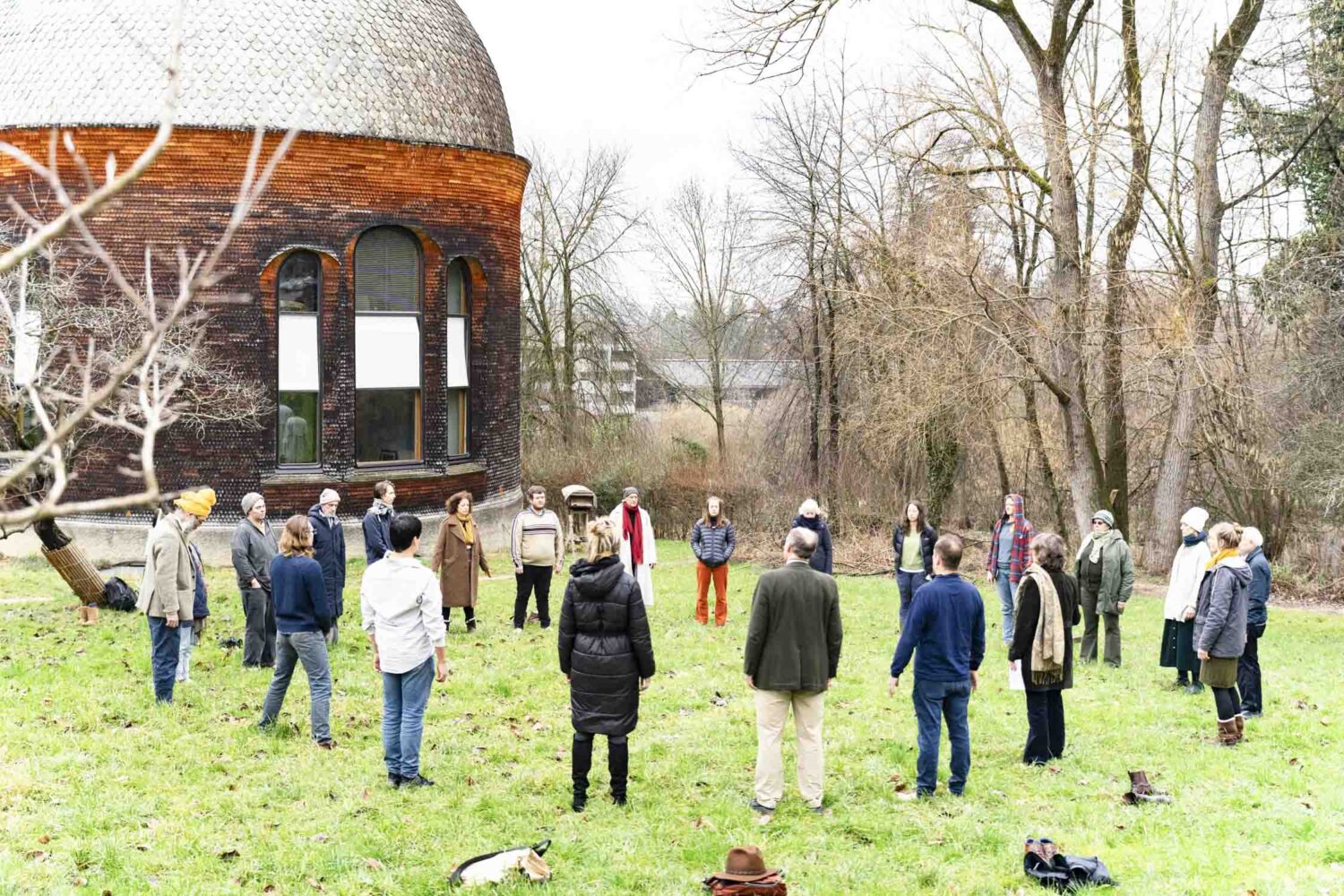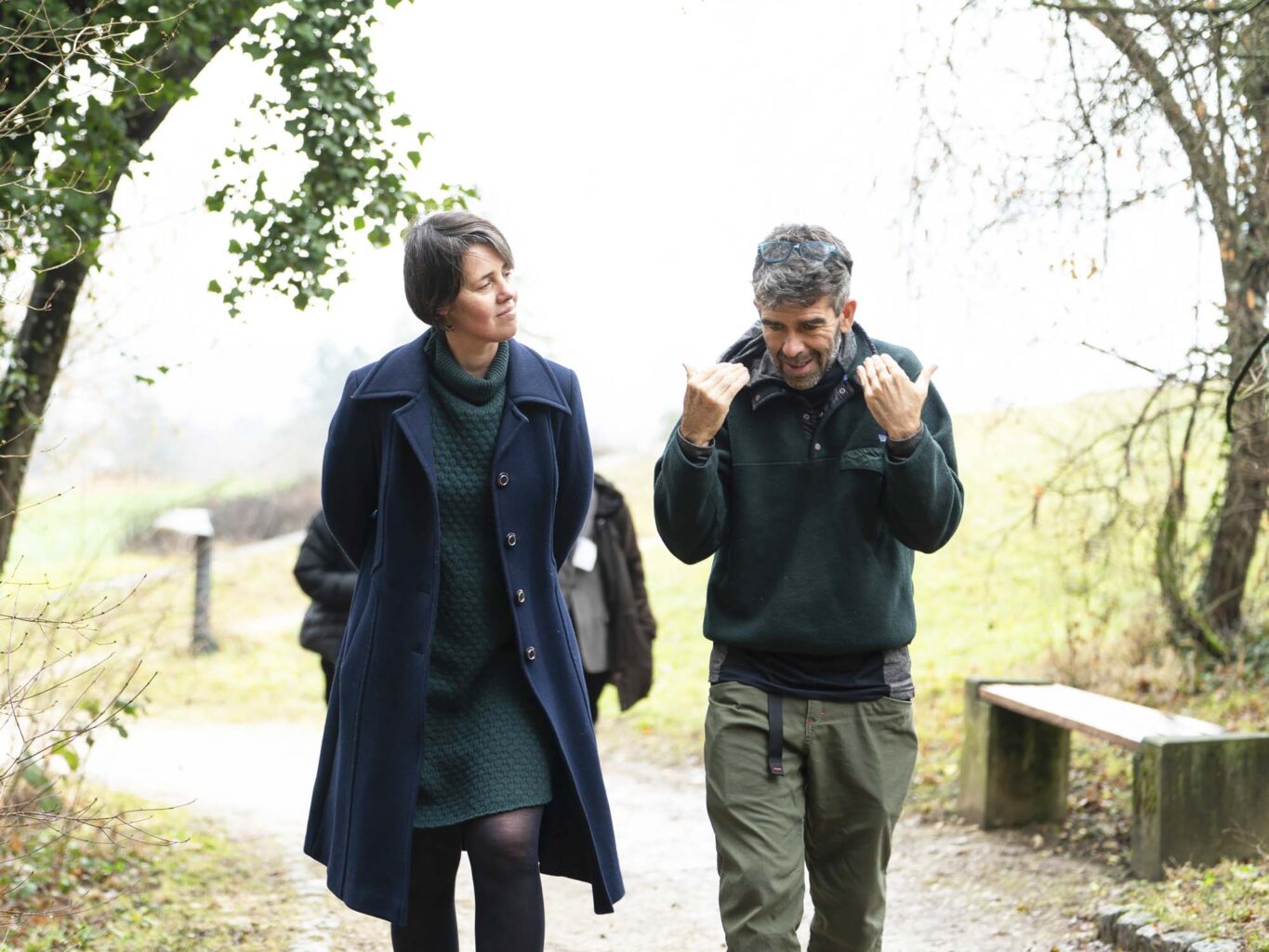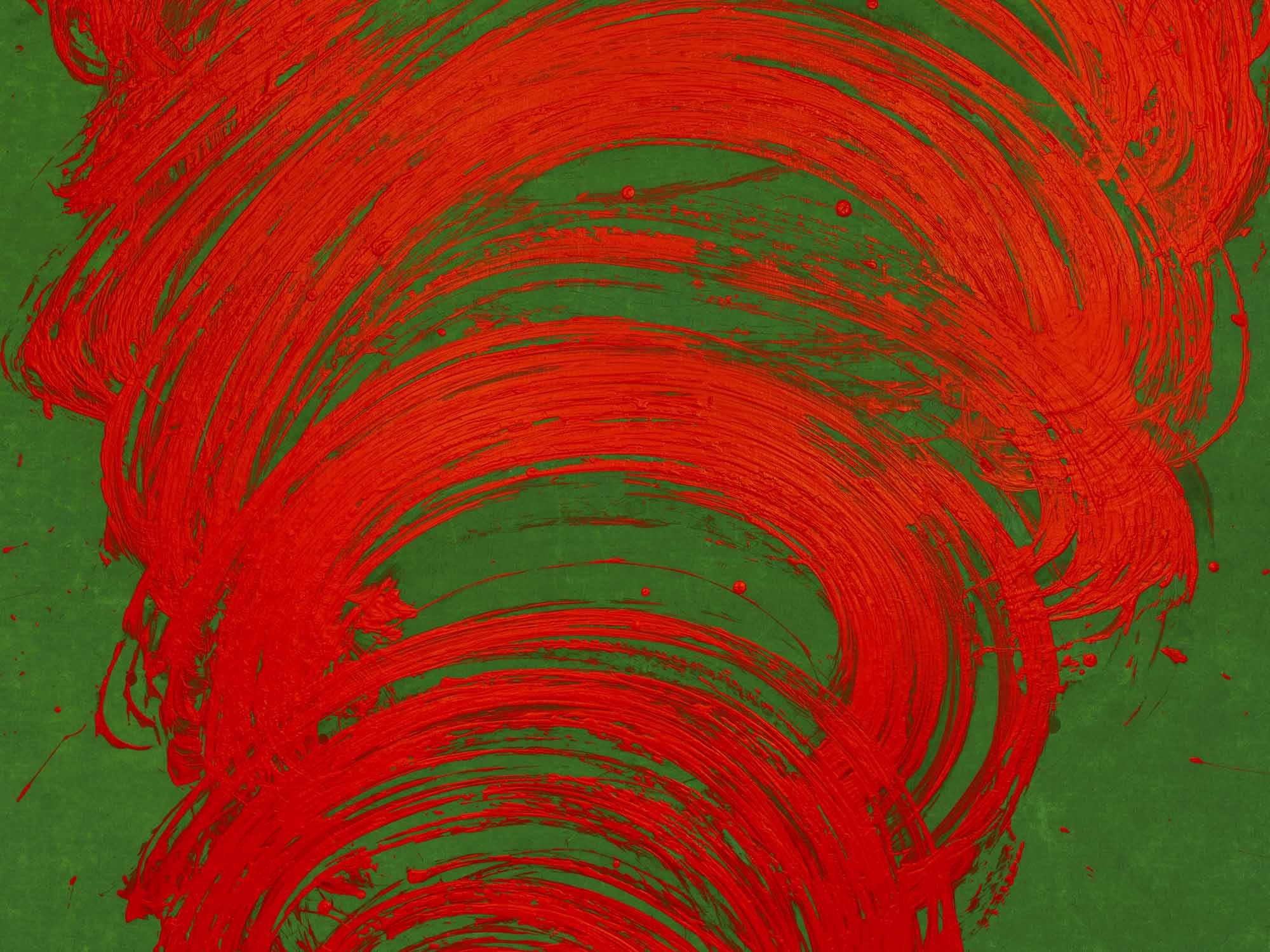In the Agriculture Course,1 Rudolf Steiner developed the concept of an “agricultural individuality” in a truly authentic way. For many biodynamic practitioners, this is the anchor of their existence and commitment—they would rather sell their best cow than give up solidarity with their “agricultural individuality.” Even today, there is still something enigmatic about the concept—it points to the potential for an inner connection between human being, farm, and Earth. Ueli Hurter spoke about this at this year’s Agriculture Conference. Here are excerpts from his talk.
In the Michael Letters2 [which were studied during the conference,] Rudolf Steiner describes how responsibility for the Earth lies more and more in our hands. We read in the letters that the archangel Michael collaborates with Christ, the Cosmic Sun Being in anthroposophy, akin to Ahura Mazdao in the Persian spiritual tradition or the Egyptian Ra or the Greek Zeus. In the choir of archangels, Michael is the one connected with the Sun. According to Christian tradition, this Sun Spirit, Christ, left the Sun and united with the Earth—the Earth becoming a sun! What we want to investigate is whether we can connect this outer image, “Christ as the Sun Spirit of the Earth,” with the inner experience of “Christ in me” and also whether we can understand what we call “agricultural individuality” as a gateway through which we can enter, in order to connect the innermost, the most personal within humanity, with something that has meaning for the whole Earth and Cosmos.
Rudolf Steiner established the concept of “agricultural individuality” in the Agriculture Course. While we are considering this, let’s not forget that our book, CW 327, is not the Agriculture Course per se, but its transcript. The course was, undoubtedly, a wholly different story between the lecturer, Steiner, and the audience. It was held in a special place, Koberwitz, and it was over Pentecost: a festive mood. All of that is also part of the Agricultural Course! Fortunately, we have this transcript and can recreate the situation anew as we read it.
Traveling from Dornach, Rudolf Steiner arrived in Breslau on the evening of June 6, 1924. That’s 1300 kilometers [800 miles] by train—a long journey!—followed by an hour’s drive to the Koberwitz estate. Those present were shocked to see how exhausted Steiner looked. The first lecture was held the next morning. Steiner’s first drawing was a small circle surrounded by a large circle: the 30-year orbit of Saturn—an enormous starting point at a grand scale. This is how Steiner set the stage for the course—not your usual agronomy lecture! Then, there was a two-day break for the Pentecost holiday. So, the second lecture was a kind of new beginning. “Now, a farm comes closest to its own essence when it can be conceived of as a kind of independent individuality, a self-contained individuality.” That is the actual beginning of the Agriculture Course! A self-contained individuality—the theme is set from the beginning and is then elaborated.
The Beginning of New Economic Activity
In this sense, all eight lectures are explanations of agricultural individuality. In the second lecture, this is first described as autonomous individuality, meaning that the farm should bring forth out of itself whatever it needs to be productive. Fertilizers, healthy resources, and means of production, i.e., soil, plants, and animals, must all come, as much as possible, from the farm itself. This is not the start of a small vision for agriculture but rather the beginning of a new economic activity.
Next, the soil is considered—again from the point of view of agricultural individuality. “If we compare the soil to a human diaphragm, we then have to say that the head of the individuality in question is underground, and we, and all our farm animals, are living in the belly of this individuality.” So, along with autonomy, we have a second criterion: in contrast to us human beings, this individuality is standing on its head.
Then, the term reappears again when we get to the eighth lecture, in relation to the potential for egohood that the cow carries within herself, as a world champion of digestion. It would be possible for her to form an “I”-ness, but she renounces this possibility and remains in dreaming consciousness, giving this potential force to the environment through her manure. With the dung, this “I”-ness becomes available for the whole enterprise. The “I”-ness is not only in the cow, not only in the plant, but it is now the emerging “I”-potentiality of the whole agricultural individuality or agricultural organism. That is the third aspect.
The fourth is the interaction of these three, an interaction that we should understand in a progressive sequence: a whole is formed, standing on its head, that we, as farmers, encounter in such a way that one is fostered through the other, from year to year.

Now, let’s return to the mysterious, enigmatic nature of this concept and ask: has there ever been an agronomy that spoke of individuality? This is not a scientific concept—it must first find a home in agriculture. Indeed, it comes out of anthropology, out of anthroposophy. We can see that these concepts which Steiner developed for agriculture are broadly defined—they are like the Earth: open. These concepts are open, all the way to Saturn. So, we must be clear that the concept of individuality has no place in agriculture in the classical sense but rather is introduced here by Steiner, without hesitation, right at the beginning of the course, and thus sets the tone.
Human individuality means becoming who we are, being able to decide for ourselves, and being responsible for the consequences of our behavior. Child and adolescent development show that individualization occurs step by step. It is a path that leads us over from being one with our surroundings to walking, speaking, and thinking as we mature to school age and to our first sovereignty. Our individuality unfolds with the primal experience of loneliness at the age of nine and during puberty with the experience of our first love. Then, we take individualization into our own hands.
The Dual Gesture of Individual-Representative
The same applies to society as a whole: through a multitude of steps, from antiquity to the Renaissance, we developed from group consciousness to individual consciousness. And this process of becoming unique means that we become, at the same time, more universal. I, as an individual, am becoming ever more a representative of the universally human, of humanity, of human potentiality in general. I become more independent from my personal family and develop my individuality further. Thus, I am then able to speak for the village, and if I continue to further realize my individuality, I can even become the representative of the region. Indeed, there are human beings who become the representative of an entire generation. This is a dual gesture. We become more our own but in a grand way.
Two examples: Alexander the Great meets the philosopher Diogenes, who lives in a barrel. Nevertheless, Alexander wants to learn from the thinker and asks him what he can do for him. Diogenes replies, “Get out of my sunlight.” Here, the inner and the outer are still divided between two human beings. A second example: as a black man in South Africa, Nelson Mandela fights against the apartheid regime and is sent to prison for 27 years. He does not allow himself to be broken; he works every day to develop his individuality so that the people in South Africa feel this work, even during his imprisonment. He was released and elected President of South Africa and can now be President for everyone. This is expressed in his inauguration speech, in which he quotes the American peace activist Marianne Williamson: “Our deepest fear is not that we are inadequate. Our deepest fear is that we are powerful beyond measure. It is our light, not our darkness, that most frightens us.” In this moment, when he outwardly portrays this image as President, the inner sun is with him. This is the concept of individuality, as we can comprehend it in terms of cultural history.

Individuality: Anthroposophical and Biodynamic
How does Rudolf Steiner deal with the concept of individuality? How do these two streams, the language of Michael-Christ and the language of the Agriculture Course, come together? Four steps are described in the course: autonomy, standing on one’s head, the principle of the cow transferred to the whole farm via the manure, and the handling of these three by the “I” of the farmer.
First step, physical. Become who you are. That which you are is not what you can potentially become. We are invited to embark on a journey with ourselves.
Second step, etheric. Am I now conscious of my “I”? When we concentrate on saying “I” to ourselves, our personality appears as a point. All that we have ever lived through and experienced is gathered together and focused at this point. It is a gigantic gesture. When I say “I” to myself, all that I am in my life gathers in a concentrated way, like the perspectival vanishing point of my life. This point becomes the eye of a needle, a passage into a new space beyond the world of objects, into a counterspace, where I inwardly experience the widths of the world, where the world of the elements, the atmospheric, plays out. I experience my peripheral self, my “I” as circumference. What corresponds to this “shift” in the agricultural individuality? The turn-around of above and below! We could easily think that the plant is in the soil with its roots to take up the nutrients, and it is in the air with its leaves to perceive. But really, it is the other way around! It perceives with its roots and digests in the air and light space, where everything from light and air to the planetary constellations is actually absorbed into the metabolism. The plant grows from top to bottom. We only see it growing from the bottom up. The formation of fresh substances takes place in the green leaves. Naturally, the mineral substances come up from below, with the flow of salt water, but they are the result of a process of perception and thought and not of the plant’s will to nourish itself.
Third step, soul. Now, I live in this relationship of center and periphery. I am periphery and center; I am this field of tension. Can I let the one merge into the other? From the point to the periphery? Steiner gave the point-periphery meditation in the Curative Education Course a few days after the Agriculture Course.3 “I in God. God in me.” When I make this alive within myself, I experience a second center. The ‘“I”-point suddenly has a sibling, a second center. There is a being, and it is no longer centric. I am eccentric. That is the experience of reality: becoming eccentric. And this other “I,” that is the “I” of the You. It looks at me and speaks to me: I am because you are. Everything that has been a “thing” becomes You, a Being: the minerals, the stars, the plants, the animals—a branch moved by the breeze. I step into the world, which emerges as the conversation of beings with one another. I step into the conversation of the world, a conversation of beings with each other. When we transfer this to the agricultural individuality, we see that autonomy is necessary so that this inner conversation can take place. The neighbor’s manure is just as good as my own, but for my farm, I need the manure that arises on my plot of land from the fodder through my cows. Autonomy creates inner warmth, inner light, an inner conversation. There arises the intimate, trustworthy force of self-organization. One step occurs after three years, another after seven years and, suddenly, this agricultural individuality begins to sustain itself. When, as in my case, you have been able to develop a farm for over thirty years, then this individuality becomes a real partner. From there comes peace and stability. That is inner autonomy. It arises through solidarity.
Fourth step, “I”-ness. This conversation of beings, of which I become a part, tells of a before and an after. In me, pre-birth is present, and after-death is active. The gates of birth and death open. I do not experience my individuality as limited to this life. This is a wholly individual path for each and every one of us. It is the entanglement of the individual and the universal anew. In this way, every human being is “One who is Becoming” on their path, but in this way, they are also bound to all other human beings, who also are each “One who is Becoming.”
This opening, the way that this can have an effect, is also the gesture of the preparations. Something is being called down into our agricultural activities that has not yet been there. There are new substances that we are forming, and there are new forces being called in. According to Steiner, agriculture, in particular, shows that forces that are completely unknown today must be called forth from the spirit, and these forces have significance not only for improving agriculture a little but also for ensuring that human life can continue on earth, even in the physical sense.
When we comprehend the Earth as becoming Sun, we enter into the language of Michael-Christ. We realize that we are one with creation—that minerals, plants, and animals are sisters and brothers and that we share this Earth. We become conscious that we are a special sibling because we are predisposed to think for ourselves, feel for ourselves, and have our own will. We are not only natural beings but also spiritual ones. And that brings us into this field of tension with nature, with the Earth.
We have centuries behind us in which we have taken more than we have given. This imbalance was fine because that is how our freedom became possible. How can it be turned around? This is the grand dimension of development, which has come to the point of Earth’s desolation and the desolation of us human beings in our own essential being. The direction of development needed to be reversed. Cosmologically, it is the deed of Christ, who accomplished this reversal. He is the Sun Being; he left his Sun home, became human, went through death, overcame death, and thereby bound himself together with everything earthly. And, through this, the Earth began to germinate like a seed—the Earth has new germinating forces within it. Plants, animals, and soil begin to carry germinal forces in order to light up anew. This is the deed of the Sun Being, who is called Christ in these contexts and who is not to be confused with the appellation Christ, as is used in an ecclesiastical-religious context. Anthroposophy respects all religious attitudes.
From Regenerating to Generating
For us human beings, this deed does not signify less freedom but actually more. The inner experience of the warmth of the Sun and the sunlight of Christ can be so intimate—here, the dual nature of the individual becomes apparent again—that it enables us to connect with all other human beings in our shared human responsibility. And our common responsibility now consists of the fact that the Earth wants to be included in our destiny as human beings—Earth is our destiny, individually and collaboratively. How can I express this in my life? No one can carry the entire Earth—everyone is on their own. To then turn to a piece of Earth, to take care of it so it can potentially be able to develop in a direction of individualization, as an expression of the whole Earth at that one point—is this not the concept of agricultural individuality? Isn’t that what is “secretly” embedded in the Agricultural Course? So, we can say that every farm can be a representative of the whole Earth, meaning: A seed for the future of the Earth lives here. New germinating forces work here. Here, through solidarity, new spirituality will be called in. Here, nature is not only regenerated but generated. Here, we work creatively from out of the future, on and with the Earth.
Translation Joshua Kelberman
Title image Fabienne Verdier, Se tu lo lasci far, 2020, 183 × 135 cm, acrylic, Courtesy Galerie Lelong & Co. et Waddington Custot
Footnotes
- Rudolf Steiner, Agriculture Course, CW 327 (Forest Row, E. Sussex: Rudolf Steiner Press, 2004).
- Rudolf Steiner, Anthroposophical Leading Thoughts. Anthroposophy as a Path of Knowledge. The Michael Mystery, CW 26 (Forest Row, E. Sussex: Rudolf Steiner Press, 2007).
- Rudolf Steiner, Education for Special Needs: The Curative Education Course, CW 317 (Forest Row, E. Sussex: Rudolf Steiner Press, 2015), lectures in Dornach, June 25–July 7, 1924.













